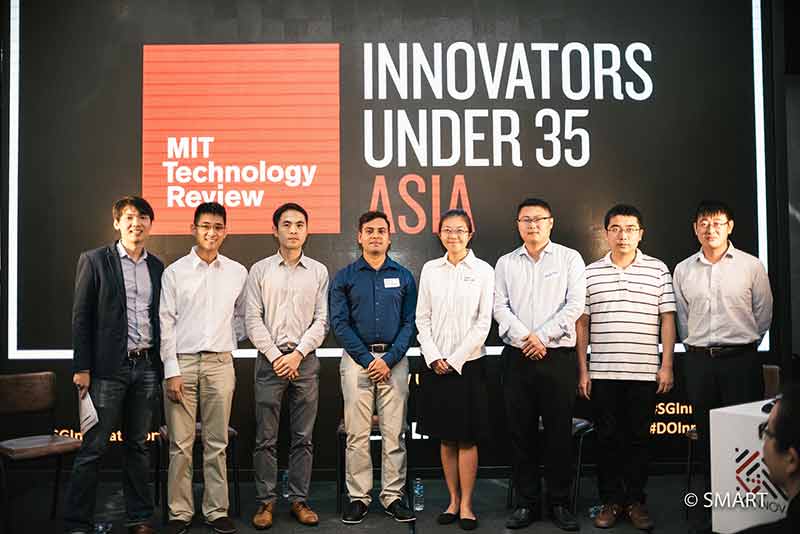
Sensors inspired by blind cave fish, energy-generating wastewater
treatment plants, rapid evaluation of the efficacy of cancer drug regimens, functional
genomics merged with artificial intelligence – these were some of the
innovations by the top 10 young Innovators under the age of 35 in Asia
recognised by the MIT Technology
Review on November 21.
The list recognises the development of new technology or the
creative application of existing technologies to solve global problems in
industries such as biomedicine, computing, communications, energy, materials,
web, and transportation.
This year, the researchers and entrepreneurs come from
Singapore, Australia and Taiwan. The 10 selected innovators will present a
three-minute elevator pitch at EmTech Asia and will automatically become finalists
for the global Innovators Under 35 list. Past honorees of the global list
include Larry Page and Sergey Brin, the cofounders of Google; Mark Zuckerberg,
the cofounder of Facebook; Jonathan Ive, the chief designer of Apple; and
Daniel Ek, co-founder of Spotify.
SGInnovate (a private-limited company wholly owned by the
Singapore Government), which seeks to develop the startup ecosystem in
Singapore, will host the ‘Innovators Under 35’ (IU35) segment.
Steve Leonard, Founding Chief Executive Officer of
SGInnovate, said, “We are thrilled to be supporting IU35 for the
second consecutive year. At SGInnovate, we strongly believe that ‘deep-tech’
startups will be critical players in tackling global challenges in new ways.
These young scientists are working in areas such as energy, transportation,
artificial intelligence, and biomedicine. All of these are vital to the future
of humanity. We want to encourage and help these amazing men and women to have
the courage and confidence to bring their research work to the market – where
millions of lives could potentially be transformed.”
Now in its fifth edition, the “Innovators Under 35 Asia”
program received a total of 132 nominations from talented researchers,
inventors and entrepreneurs from countries including Singapore, Malaysia, Thailand,
Philippines, Indonesia, Vietnam, Taiwan, Australia and New Zealand, for
consideration for the 2018 list.
Ajay Prakash Kottapalli (Singapore),
SMART
Dr. Kottapalli
is currently a Project Investigator (PI) for research projects funded by the Singapore MIT Alliance for Research and
Technology (SMART) Innovation Center and the CENSAM (Center for
Environmental Sensing and Modeling) Research Initiative. In 2016, Ajay founded
a startup company called Sensornomics Pte Ltd which envisions to create new
standards of care in biomedical devices.
He is working on the development of ultra-sensitive, nature-inspired
miniaturised sensors that can be used for biomedical flow sensing and are cheap
enough to produce and use on a large scale.
Blind cave fish have an uncanny ability to swim adeptly at
high speeds without colliding with obstacles and finding food even faster than
the eyed fish. They do so through flow sensors on their body which can measure
minute disturbances. After understanding the biology of the sensors, he was
able to produce sensors as cheap as 20 cents and which could measure flow
velocities as low as 1 ml/sec. These can be useful for intravenous infusion.
He is also working on sensors inspired by whiskers of
harbour seals, which are used to track fishes underwater and also, by the hair
cells in the cochlea, an organ in the ears of mammals. All these sensors could
have a wide range of applications in the biomedical area and others as well.
For instance, they could be used on underwater vehicles to measure flows around
the vehicle and for object detection and object avoidance.
Anjali Jaiprakash (Australia) Queensland University of
Technology
Dr. Anjali Jaiprakash is working Light field retinal
diagnostic system to decrease preventable blindness globally.
She is an Advance QLD research fellow at the Australian
Centre for Robotic Vision and Queensland University of Technology. She is a
Robobiologist with a PhD in Applied Science and a Master’s degree in
Biotechnology and Business. Anjali is developing medical devices that translate
robotic vision into affordable systems that can be used to improve healthcare
outcomes, through a transdisciplinary approach, that encompasses medicine,
engineering and design.
This includes a light field retinal diagnostic system to
replace the expensive and complex cameras currently used to detect
abnormalities such as glaucoma or macular degeneration and decrease preventable
blindness.
Khoo Bee Luan (Singapore), SMART
Dr. Khoo Bee Luan is a biomedical scientist focused on
innovating microfluidic devices for clinical utility. She leads a research team
under the Young Investigator grant award by the National Medical Research
Council (NMRC)
which is designing microfluidic models to deliver real-time therapeutic
read-outs with direct translational relevance for cancer.
One of the devices she is working on is the Circulating
Tumour Cell (CTC) Cluster Assay. This assay capitalises on the utility of the liquid
biopsy, which is simply a blood sample from the cancer patient. Liquid biopsies
are relatively non-invasive as compared to current diagnostic procedures like
tumour biopsy, or tissue aspiration.
The blood sample is processed for a short-term culture to
derive a phenotype that can help find out if the patient is responding to
treatment or not. This can help in the evaluation of treatments, as well as
drugs, new and old. If the patient is not responding to the drug regime, the
clinician can step in and alter the treatment to suit the patient better,
thereby contributing to the development of personalised medicine.
She has also developed microfluidic biochips for isolation
of primary cancer cells, diseased blood cells or malaria-infected cells with
relevance to early disease detection. For example in cancer, CTC counts could
be provided simply after a few hours of processing through the micro-fluidic
biochip.
Jiashi Feng (Singapore), National University of Singapore
Dr. Jiashi Feng, currently an Assistant Professor with
Department of ECE at the National University of Singapore (NUS) is enabling
computers to grow learning ability with dynamic neural networks. His current
research interest focusses on AI, machine learning and computer vision. He has
published over 100 research papers in machine learning, deep learning, object
recognition and big data analysis.
Wesley Zheng Guangyuan (Singapore), IMRE, A*STAR
Dr. Zheng is a Scientist at A*STAR’s (Agency for Science,
Technology and Research) Institute for Materials Research and Engineering
(IMRE) and an Adjunct Assistant Professor in NUS.
His research work focused on developing high capacity
electrodes for the next-generation lithium batteries, with automotive, aerial
and renewable storage applications. The new battery technology can theoretically
have 5 times the energy compared to the common lithium ion batteries used
currently. The current prototype cells achieve
about 1.5 to 2 times.
Dr. Zheng also co-founded a venture-backed startup
(volans-i) to develop high-payload, long-range delivery drone.
Chun-Hao Huang (Taiwan), CLINICAI Inc
Dr. Huang is merging functional genomics and artificial
intelligence for disease detection and treatment.
Dr. Huang is a Cancer Biologist, Genetic Engineer and AI
Entrepreneur. He pioneered the establishment of fast and flexible genetically
engineered mouse models using gene silencing and editing technologies, and led
the discovery of therapeutic strategies for treating liver cancer and
inflammatory bowel disease.
He also invented methods to identify disease biomarkers that
predict drug responses, and applied machine learning to the study of genes.
Min Hao Wong (Singapore), Massachusetts Institute of
Technology
Min Hao Wong is developing unique nanosensor constructs for
smart agriculture application.
He is currently a Chemical Engineering graduate student at
MIT. His PhD research involved the development of unique nanosensor
applications for agriculture. His work has been featured in global media
outlets such as FOX, Forbes, TIME, BBC, and CBS. BostInno named his work as one
of the top 7 inventions to come out of MIT in 2016. Min Hao is also currently actively
running Plantea, a start-up company focused on agricultural nanosensors. He is
also the co-president of the South-East Asia Club, vice president of the MIT
energy club, and a guest lecturer for 10.585 Engineering Nanotechnology.
Qilin Wang (Australia), Griffith University
Dr Qilin Wang is an Australian Research Council (ARC) DECRA
Research Fellow & Lecturer at Griffith University in Australia. Dr. Wang’s
research focuses on innovative biotechnologies for maximising energy
recovery/production from wastewater. As a Principal Investigator (PI) or Co-PI,
he has been awarded 7 competitive grants with a total research funding of ~$AUD
3.6 Million from Australian government, State government, industry and
university.
Dr. Wang explained, “Wastewater treatment plants consume a
lot of energy. But wastewater also contains a lot of energy. The basic idea is
that if we can recover the energy from the wastewater, we can use the recovered
energy for the operation of the wastewater plant. We can even export the excess
energy into the grid. We can convert the wastewater treatment plants from large
energy consumers to energy generators.”
Currently, most of the technologies for generating energy
from wastewater consume a lot of chemicals. Dr. Wang instead uses a chemical which
is present in the wastewater itself.
The wastewater sludge containing a lot of organic material, will
usually go through an anaerobic digester in the treatment plant to produce
biogas but only a small fraction of the wastewater sludge can be used so. After
the sludge is treated using the chemical present in the wastewater, maybe
50-60% of the sludge can be used for producing biogas, compared to say 30%
earlier.
Dr. Wang has applied for a patent for the technology and he
is also working with a company for its commercialisation.

Weibo Gao (Singapore), Nanyang Technological University
Dr. Gao was recognised for his exploration of spin photon
interface for the application in quantum network and quantum information
processing.
Currently he is a Nanyang assistant professor in NTU. His
research in quantum information and quantum photonics is published in several
world class journals such as Nature, Nature physics, Nature photonics and
Nature communications. Previously he has won the Marie-Curie Fellowship in
European Union, the recipient of National 100 Excellent Doctoral Dissertation
Award in China, and Singapore National Research Foundation fellowship awards.
Yok Hian Chionh (Singapore),
Tychan Pte. Ltd., SMART
Yok Hian Chionh believes that the war against infections can
be won if we proactively create systems that rapidly design cures, respond to,
and treat patients during outbreaks. As a scientist, he discovered fundamental
properties of genetic coding that enabled pathogens to survive hostile
environments. As a drug developer, he helped bring an anti-Zika therapeutic
from bench-to-bedside. He is exploring radically different science-based
regulatory frameworks to expedite regulatory approvals of therapeutics, while
meeting safety and efficacy requirements.
The medical sector is highly regulated and conservative. To bring about a change, you need evidence. If equivalence can be proven among different tests or different products, then it can be effectively communicated that they are one and the same (two pharmaceutical products are bioequivalent if they are pharmaceutically equivalent and their bioavailabilities (rate and extent of availability) after administration in the same dose are similar to such a degree that their effects, with respect to both efficacy and safety, can be expected to be essentially the same.)
Today in drug trials around the world, everything is systematic
with no exceptions. The current regulatory frameworks provide for a systematic
approach to ensure that every single product made is exactly the same for
drugs. For trials, there’s an established sequential process, starting with a
small group, moving on to bigger groups and finally to the market.
Everything is put in place for a reason, most of them
historical. But there are better ways to do things right now. “In the context, of epidemics, outbreaks of
infectious diseases, drug-resistant, in order to save lives (I don’t mean 1 or
2 lives, it is about thousands of lives) we need a new approach. You cannot
wait 5 years or more for a new drug. People need the drugs now. That is what
the radically different approach is. It is really common-sense. You do not want
to do things in a stepwise manner and wait for the results from A, before you
do B, when we can do A and B at the same time,” said Yok Hian Chionh.
















